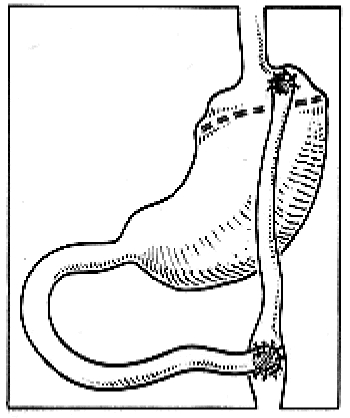|
What exactly is Roux en-Y (RNY) Surgery? The Roux en-Y (RNY) was my surgery of choice and I have been extremely pleased with the results. RNY gastric bypass surgery is considered to be the "gold standard" in gastric bypass surgeries. It was named after a 19th century French surgeon, Dr. Phillibart Roux and was developed by Dr. Ward Griffin of the University of Kentucky. This type of surgery has the best success rate for weight loss, short-term as well as long-term and has been endorsed by the National Institute of Health. Although it is complex and difficult, it has the same mortality rate as general surgery. This type of surgery produces a feeling of being full when eating a very small amount of food and produces a feeling of being satisfied. In many patients, a symptom called dumping, which is discussed later, results in an inability to eat sweets therefore aiding in the weight loss and weight maintenance process. Finally the bypassing of part of the small intestines results in fewer calories being absorbed. In this procedure, the stomach is separated into two sections. The upper part is made into a very small pouch that holds 1 to 2 ounces initially. It is about the size of your thumb. A normal stomach holds 40 to 50 ounces and is roughly the size of a personís head. The small pouch is at the bottom of the esophagus and is very resistant to stretching. The lower part of the stomach is not removed. Nothing enters it but it does still produce gastric juices, which aids the digestion process by eventually joining with the food in the small intestines. These two parts of the stomach are completely separated and are closed by a method of stapling and sewing to eliminate the chance of leaks. A leak is a very rare and serious condition allowing food to enter the abdominal cavity causing infection. Scar tissue eventually forms at the stapled and sewn area so that the pouch and stomach are permanently separated and sealed.
After the stomach is divided, the small intestine is cut about 18 inches below the old stomach. The cut end of the intestine is looped up and then connected to the new small pouch, which will hold all of the food as it is eaten. The 18 inches of intestines, which are left attached to the old stomach, are now bypassed in the digestive process. The opening between the new pouch and the intestines is called a stoma and is about the size of a pencil eraser or about 1/4 inch in diameter. This small outlet delays the emptying of food from the pouch and causes a feeling of fullness. Because the pyloric valve between the stomach and the duodeum is bypassed, it is important that the size of the stoma be small so that food will remain longer in the pouch. It is important to chew food well so that it does not get caught in the stoma. If that happens, the food will eventually pass through. If this opening is too small or closes because of swelling or a build up of scar tissue, an endoscopic procedure must be done to enlarge the stoma. Because the food that is eaten soon comes in contact with the lining of the upper small intestines, it is believed that this causes the release of hormones causing the patient to feel satisfied and no longer hungry. Ordinarily this would not happen for 30 to 60 minutes. Because it happens so rapidly with RNY patients, they avoid overeating. It often happens with RNY patients that they lose the physical sensation of hunger and the mental compulsion to eat. The small intestines from the upper functioning small stomach and the small intestines from the old large lower stomach are joined in a Y connection so that the gastric juices can mix with the food coming from the small pouch. Although the old larger stomach does not receive any food, it does not wither and die. It still produces digestive fluids that eventually meet up with the food that is passed down from the new little pouch. For most people the ability to eat large amounts of food is lost forever, but some people do return to being able to eat modest amounts of food without feeling hungry. The initial success rate with this surgery is 80 to 100% and the long-term success rate is equally impressive. Disadvantages include the dumping syndrome. This usually occurs when something sweet is eaten. When the food enters the small intestines it can cause cramping, sweating, nausea, etc. Dumping is sometimes viewed as an advantage, however, because it discourages people from eating sweets. Nutritional deficiencies can result if a regime of vitamins is not followed. The stoma, or opening between the stomach and intestines, can sometimes become too small, causing vomiting. This can be repaired by an outpatient procedure that uses a small balloon to stretch the stoma. Immediately following the initial surgery, there is a small possibility of a leak occurring in the new, small pouch and is very serious. This extremely rare occurrence sometimes seals itself. If it doesnít, another operation will be required. The greatest advantage of this surgery is its success rate and that it is a permanent solution when guidelines are followed. It is the most effective method of weight loss surgery and is approved by the National Institute of Health. This procedure will not come undone like the vertical banding sometimes does. The RNY provides a feeling of fullness and of being satisfied with only small amounts of food. This allows greater control of hunger and of food obsession. |
|||
|
Copyright © 2000-2013 Barbara Thompson All Rights Reserved |
||||

